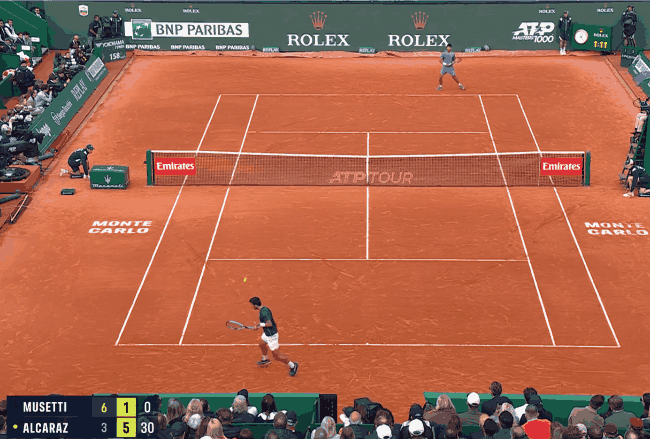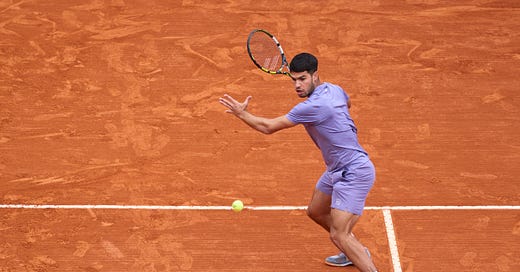Alcaraz vs Musetti: Monte-Carlo Final Analysis
Rally aggression, return positioning, drop shots and squash shots, an early tussle
Alcaraz def. Musetti 3-6, 6-1, 6-0
Carlos Alcaraz got his clay season off to the best possible start on Sunday afternoon, defeating a valiant Lorenzo Musetti in three sets to claim his maiden Monte-Carlo Masters title. The 21-year-old now has six Masters 1000 titles to his name, and will return to #2 in the world.
Let’s get into the analysis and explore the factors behind Alcaraz’s big win.
A first set tussle
The first set between Musetti and Alcaraz was tightly contested – both players wrestled for control from the outset, with momentum swinging freely and often. Alcaraz struck early with a break, set up by a lovely pass:

However, plagued again by the first-set inconsistencies that he has suffered from all tournament, Alcaraz found himself quickly under pressure. Musetti immediately broke back, and built momentum from there, largely behind his forehand wing.
Musetti was unloading on his forehand early, and a good example comes from Musetti’s break-back game at 1-0:

From here, Musetti was able to capitalise on his hot start, holding well on serve to clinch the first set 6-3. It would be remiss of me to not show the brilliant drop shot from Musetti to clinch the set – Alcaraz, for once, was on the receiving end:
Return positioning
Once again finding himself in arrears after the first set, Alcaraz made an important tactical adjustment in the second set – adjusting his return positioning notably closer to the baseline.
In the first set against Musetti, Alcaraz was standing very deep behind the baseline. As can be seen below, he’s going nearly as far back as he possibly can:
Another frame from the same point – Musetti served the ball wide to the Alcaraz forehand – look at how much space and court position Alcaraz is conceding here:
I discussed Alcaraz’s deep returning position against Djokovic in the Olympics Final, and how going this far back in the return position is often detrimental. This is particularly true on clay, where the effect of either slower return balls or shallower return depth is amplified due to the higher coefficient of restitution of clay.
However, from the second set, Alcaraz began to step up to the baseline on returns – contrast the return position below to the one shown immediately above. This gives Musetti more of a decision to make on serve, and gives Alcaraz the chance to rush Musetti for time a little more:
Here’s how the point from the above image played out. Alcaraz manages to hit an excellent backhand return, which sets him up for ascendancy in the point:
The effect of Alcaraz’s shift in return positioning can be seen in rally length statistics. In the first set on Musetti’s serve, Musetti won 8 of 11 rallies that were 5-8 shots in length – in other words, he was largely able to maintain his serving advantage in rallies of medium length.
However, in the second set, Musetti won only 3 of 9 rallies of 5-8 shots on his own serve. This suggests that Alcaraz’s move to the baseline was able to neutralise some of the serving advantage of Musetti.
While on the topic of returning, I thought it might be worth mentioning Musetti’s serving patterns. Across the tournament in general, Musetti has looked to consistently serve to the backhand of his opponents – and it was no different against Alcaraz.
Nearly three-quarters (73%) of Musetti’s first serves on the deuce court went down the T, while over half (53%) of the AD court serves went wide, both targeting the backhand pretty consistently:
It begs the question: did Musetti’s serving predictability also assist Alcaraz in finding form on his return side?
Rally aggression
One of the big contrasts in Alcaraz and Musetti’s playing styles is their rally aggression. Musetti is much more willing to grind out points on the slower clay surface. In fact, in his latest article, Jeff Sackmann noted that Musetti has one of the lowest rally aggression scores on tour. Alcaraz, on the other hand, is very proactive with his shot-making and court movement.
One of the key signals of this difference in rally aggression on Sunday was points won at the net. Alcaraz won 16 of 19 (84%) of net points – he approached the net frequently, and with great success, leveraging his great court movement and anticipation:
There was also variety within these net approaches for Alcaraz – he employed the serve and volley on 8 of those 19 net points. An example of an important serve and volley facing break point in the second set:

Alcaraz’s rally aggression is, of course, not limited to just finishing points at the net. He is lightning quick to react to shorter balls, and also possesses formidable power on his forehand and backhand wings – which allows him to naturally be more aggressive. Here’s an example of where Alcaraz’s weight of shot turns a neutral rally into an advantageous one:

Drop shots and squash shots
It’s already well known that Alcaraz on clay is a scary proposition. One reason for this is his drop shots and squash-type shots – the clay surface is a fantastic playground for Alcaraz’s variety.
In particular, drop shots are often more effective on clay due to the higher coefficient of friction relative to other surfaces – that is, the ball will grip into the surface more, arresting its forward momentum quicker and making it harder for the opponent to retrieve.
Alcaraz has been taking full advantage of this. Prior to this match, he had won 35/41 (85%) – or 5 of every 6 points – where he hit a drop shot. A phenomenal conversion rate. This did not change in his match against Musetti – winning 6 of 8 (75%) of drop-shot points.
Outside of the effect of the surface itself, one of the big reasons for Alcaraz’s drop-shot success is his ability to create space on the court – pushing his opponents deep and/or wide on the court with his big groundstrokes. This opens up the court, and means the drop shot is often a strong play.

Alongside the more conventional drop shot, Alcaraz also employs this squash-esque shot down the line at times – another example of the variety he brings:

Overall thoughts
After losing the first set for the 3rd time in 5 matches at Monte Carlo, Alcaraz lifted his level considerably in the following two sets to take control of proceedings. He adjusted his return position to great effect and found his range on his groundstrokes, utilising his ever-potent mix of power and precision.
Musetti started with a bang, but faded physically late in the match. He had a lot of trouble with his right leg in the third set, which hampered his movement around the court. He took an MTO down 0-3 in the final set and looked in a lot of discomfort – but big credit to him for sticking it out.
Both Alcaraz and Musetti have laid strong foundations for the rest of the clay court season. Musetti, having withdrawn from Barcelona, will look to recover. Alcaraz, on the other hand, will be keen to push on with his clay court form as Roland Garros approaches ever nearer.
If you want to read more:

















